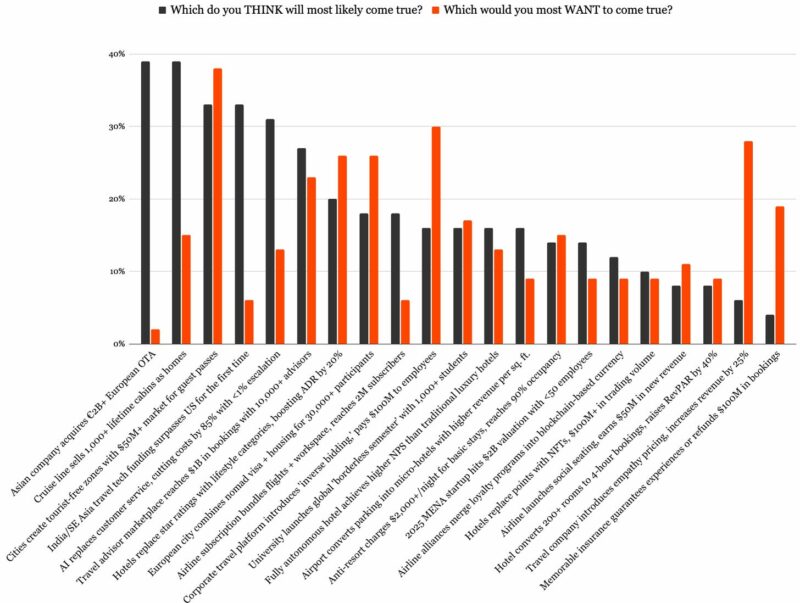
Leveraging technology is no longer a luxury—it’s a necessity. The Property Management System (PMS) is the heart of hotel management, serving as the central hub in a hotel’s technological ecosystem. It orchestrates everything from reservations and check-ins to billing and guest services. Therefore, getting the setup right is vitally important.
Unfortunately, many hotels struggle with the crucial step of setting up their PMS. The challenges are multifaceted: tech vendors often lack deep insights into hotel operations to provide meaningful assistance, and not all PMS platforms offer the same configuration possibilities. This leaves many hoteliers navigating a complex landscape without adequate support, potentially hindering their ability to maximize revenue and profits.
Enter Artificial Intelligence (AI). When effectively integrated with a well-configured PMS, AI can transform data into actionable insights, driving significant growth in revenue and profitability. However, AI is only as good as the data it works with. Accurate, comprehensive data captured by your PMS is essential for AI to deliver on its promise.
This guide bridges the gap between your PMS setup and AI’s untapped potential. We’ll provide a step-by-step outline to ensure your PMS is configured to maximize the benefits of current and future AI technologies. By understanding more about your guests and effectively managing your inventory, you can position your hotel to stay ahead of industry trends and exceed guest expectations.
Understanding More About the Guest
Guest Segmentation
Guest segmentation involves grouping guests based on variables that reflect their travel behaviors, preferences, and needs. Unlike categorizing guests by a single attribute, effective segmentation considers multiple factors to create a comprehensive profile.
The primary variables in guest segmentation are:
- Purpose or Reason for Travel: This is the most critical variable. It distinguishes guests traveling for business, leisure, conferences, or other specific purposes. Knowing why guests travel helps tailor services and marketing efforts to meet their needs.
- Origin of the Guest (Feeder Market): Understanding where your guests come from geographically allows you to customize marketing campaigns, recognize cultural preferences, and anticipate language needs.
- Booking Channel: Identifying how guests book their stay—whether through direct bookings, online travel agencies (OTAs), corporate travel agents, or Global Distribution Systems (GDS)—provides insight into their booking behaviors and potential commission costs.
Other essential variables that enhance guest segmentation include:
- Rate Code: The type of rate the guest has booked, such as corporate rates, promotional rates, or package deals.
- Length of Stay: Short stays versus extended stays can indicate different guest needs and revenue opportunities.
- Booking Window: The time between the booking and arrival dates can affect pricing strategies and occupancy forecasting.
- Number of Guests: Solo travelers, couples, families, or groups may require different room types and amenities.
A guest segment is not defined by a single variable but rather by a combination of these factors. This multifaceted approach allows a more precise understanding of guest behaviors and preferences.
Example of a Guest Segment:
An individual from the UK traveling for business, booking through a self-service corporate travel agent via a GDS, staying for three nights at a corporate rate.
This guest segment combines:
- Purpose of Travel: Business
- Feeder Market: United Kingdom
- Booking Channel: Self-service corporate travel agent through a GDS
- Rate Code: Corporate rate
- Length of Stay: Three nights
By defining guest segments through such detailed combinations, hotels can develop targeted strategies to enhance guest satisfaction and increase revenue.
Importance
Tailoring your services and marketing efforts to these detailed guest segments is crucial for several reasons:
- Personalized Experiences: Understanding each segment’s needs and preferences allows you to offer customized services. For instance, business travelers may appreciate expedited check-in, workspace amenities, or flexible checkout times.
- Targeted Marketing: Crafting marketing messages that resonate with specific segments increases engagement and conversion rates. Leisure travelers from a particular region might be interested in local attractions or special packages.
- Revenue Optimization: Analyzing different segments’ booking behaviors and spending patterns helps adjust pricing strategies and maximize profitability.
- AI-Driven Insights: Accurate segmentation feeds valuable data into AI systems, enhancing their ability to predict trends, personalize recommendations, and identify new opportunities.
Implementation
Setting up and maintaining detailed guest profiles within your PMS is essential for effective segmentation:
Data Collection:
- Booking Process: Collect essential variables during the reservation process. This may involve updating your booking forms to include fields for the travel reason, origin, and preferred booking channels.
- Check-In Procedures: Train front desk staff to verify and update guest information upon arrival.
- Guest Surveys: Utilize pre-stay or post-stay surveys to gather additional insights into guest preferences and behaviors.
Profile Creation
- Comprehensive Profiles: Use your PMS to build detailed profiles encompassing all relevant variables.
- Consistent Coding: Implement a standardized coding system for each variable (e.g., purpose of travel codes, feeder market codes, booking channel codes).
System Configuration
- Customize PMS Fields: Ensure your PMS can capture all necessary variables. If specific fields are unavailable, consult your PMS provider about customization options.
- Integration: Connect your PMS with other systems, such as channel managers and distribution channels, to facilitate data capture and analysis.
Staff Training
- Importance of Data Accuracy: Educate your team on how precise data entry impacts overall operations and AI effectiveness.
- Use of PMS Features: Provide training on correctly inputting and updating guest information within the PMS.
Data Maintenance
- Regular Audits: Periodically review guest profiles to ensure information is up-to-date and accurate.
- Data Cleaning: Remove duplicate profiles and correct inconsistencies to maintain data integrity.
By meticulously collecting and organizing guest data, you create a robust foundation for AI technologies to analyze patterns and generate actionable insights. This level of detailed segmentation enables you to:
- Enhance Guest Satisfaction: Offer services and experiences that closely align with the specific needs of each guest segment.
- Increase Operational Efficiency: Allocate resources more effectively based on the anticipated needs of different segments.
- Drive Revenue Growth: Identify high-value segments and tailor strategies to maximize profitability.
Implementing a detailed guest segmentation strategy in your PMS is critical to leveraging AI to its fullest potential. By understanding the nuanced combinations of variables that define each segment, you can deliver personalized experiences that delight guests and drive your hotel’s success.
The Importance of Collecting the Right Data
Collecting accurate and comprehensive guest data is crucial for unlocking the full potential of your PMS and the AI technologies that can leverage this data. It’s not just about filling in fields; it’s about capturing meaningful information that provides insights into your guests’ behaviors, preferences, and profitability. The correct data lets you understand your guests deeper, allowing for more personalized experiences and effective marketing strategies.
Leveraging Business Intelligence Tools
Once your hotel has meticulously collected and organized guest data, you can harness the power of business intelligence (BI) tools like Demand Calendar. These tools can cross-check variables and analyze guest spending patterns to identify your most profitable segments. Here’s how they enhance your operations:
- Cross-Referencing Variables: BI tools analyze multiple data points simultaneously—such as the purpose of travel, feeder market, booking channel, rate code, length of stay, and guest spending—to uncover patterns and correlations that aren’t immediately apparent.
- Identifying Profitable Guests: By examining the combination of variables, you can pinpoint which guest segments contribute the most to your revenue. For example, you might find that business travelers from a specific region who book through certain channels spend more on additional services like dining and spa treatments.
- Tailoring Strategies: Understanding these segments allows you to tailor marketing campaigns, promotional offers, and service enhancements to attract and retain these high-value guests.
Example of Data Utilization
Imagine you’ve collected comprehensive data and input it into a BI tool:
- Guest Profile: A traveler from the UK on a business trip, booking through a self-service corporate travel agent via a GDS, staying for four nights, and frequently using the hotel’s dining and wellness facilities.
- Analysis: The BI tool reveals that guests matching this profile have a higher average spend and longer booking window, making them ideal targets for early-bird promotions or loyalty programs.
- Actionable Insights:
- Marketing: Develop targeted email campaigns offering special rates or packages that include dining or spa credits.
- Revenue Management: Adjust pricing strategies to maximize occupancy and revenue during periods when these guests are most likely to book.
- Service Enhancement: Offer personalized services such as flexible check-in/out times or complimentary meeting room access.
The Role of AI in Data Analysis
AI technologies excel at processing large datasets to identify trends and make predictions. With accurate and detailed guest data:
- Predictive Analytics: AI can more accurately forecast booking trends, occupancy rates, and revenue projections.
- Personalization: Tailor guest experiences by anticipating needs and preferences based on past behaviors.
- Operational Efficiency: Optimize staffing, inventory, and resource allocation by predicting demand patterns.
Benefits of Accurate Data Collection
- Enhanced Guest Satisfaction: Personalized services increase guest satisfaction and repeat business.
- Increased Revenue: Identifying and focusing on profitable segments boosts overall revenue.
- Competitive Advantage: Leveraging AI and BI tools set your hotel apart in a competitive market.
Implementation Strategies
- PMS Configuration: Ensure your PMS is set up to capture all relevant data points. Customize fields if necessary to include variables like the purpose of travel, feeder market, and booking channel.
- Staff Training: Educate your team on the importance of collecting accurate data and how it impacts overall business performance.
- Data Quality Management: Regularly audit your data for accuracy and completeness. Clean data is essential for reliable AI and BI outputs.
- Integration with BI Tools: Connect your PMS with BI tools like Demand Calendar to facilitate seamless data analysis.
Conclusion
Collecting the correct data transforms your PMS from a simple management tool into a powerful growth engine. By feeding accurate, comprehensive data into AI and BI systems, you unlock insights to identify your most profitable guests, tailor your services, and drive revenue and profit growth.
By emphasizing the importance of collecting the correct data and leveraging advanced analytical tools, your hotel can make informed decisions that enhance guest experiences and optimize profitability.
Managing Inventory
Establishing a Rate Structure and Rate Plans
Creating a flexible and dynamic rate structure is essential for maximizing your hotel’s revenue potential. As we discussed earlier, the starting point for your rate structure should be the purpose of the guest’s visit to the destination. By aligning your rate plans with the reasons guests travel, you can offer more relevant and attractive pricing options that meet their needs.
Aligning Rates with Purpose of Visit
Business Travelers
- Standard Business Rates: Base rates for individual business travelers needing standard accommodations.
- Corporate Negotiated Rates: Special rates agreed upon with specific companies to encourage repeat bookings.
- Business Travel Agent Rates: Rates are offered through corporate travel agents and are often booked via GDS.
- Overnight Meeting Rates: Packages that include meeting room access, equipment, and accommodations for conference attendees.
Leisure Travelers
- Standard Leisure Rates: Base rates for vacationers and tourists.
- Package Deals: Offerings may include breakfast, spa services, or local attractions.
- Advance Purchase Rates: Discounts are available for guests who book well in advance, encouraging early reservations.
- Promotional Rates: Special offers for holidays, events, or limited-time promotions.
By starting with the purpose of the visit, you ensure that your rate plans are directly relevant to your target guest segments. This alignment enhances the guest experience by providing options that suit their travel needs and preferences.
Importance
An effective rate structure aligned with the purpose of the visit is pivotal for the following:
- Enhanced Guest Attraction: Guests are more likely to book when they find rates tailored to their needs.
- Competitive Edge: Offering specialized rates differentiates your hotel in the market.
- Maximizing Revenue per Available Room (RevPAR): You can optimize occupancy and revenue by targeting different segments with appropriate rates.
- Improved Guest Satisfaction: When guests feel that a rate plan is designed for them, it enhances their overall experience.
Benefits
- Targeted Marketing: With rate plans tied to the purpose of the visit, marketing efforts can be more focused and effective.
- Increased Conversion Rates: Guests are more likely to book when they find a rate that aligns with their travel purpose.
- Enhanced Revenue Management: Understanding which rates perform best for each segment allows for better forecasting and strategy adjustments.
- Data Enrichment: Collecting booking data associated with specific rate plans enhances AI analytics capabilities.
Implementation
Setting up an adequate rate structure in your PMS involves:
Defining Rate Plans Based on Purpose of Visit
- Identify Key Guest Segments: Use your guest segmentation data to understand the primary purposes of visits among your guests.
- Develop Specific Rate Plans: Create rate codes that correspond to each purpose of the visit.
Creating Rate Codes and Descriptions
- Clear Naming Conventions: Use descriptive names for rate codes (e.g., “CORP_NEG” for corporate negotiated rates).
- Detailed Descriptions: Include specifics about what each rate plan offers to avoid confusion.
Linking Rates to Room Categories and Segments
- Assign Appropriate Room Types: Ensure each rate plan is linked to suitable room categories that meet the segment’s needs.
- Segment Eligibility: Specify which guest segments can access each rate plan.
Setting Conditions and Restrictions
- Booking Channels: Determine if certain rates are only available through specific channels (e.g., direct bookings, travel agents).
- Stay Requirements: Set minimum or maximum length of stay for specific rates.
- Advance Purchase and Cancellation Policies: Define the advance purchase and cancellation terms, including how far in advance a rate can be booked.
Integrating with Distribution Channels
- Ensure Visibility: Ensure your specialized rate plans are visible on all relevant booking channels.
- Consistency Across Channels: Maintain rate parity where necessary but leverage channel-specific promotions when appropriate.
Dynamic Pricing Adjustments
- Monitor Demand and Competitor Rates: Adjust rates based on market conditions while keeping the purpose of the visit in mind.
- Utilize Revenue Management Tools: Employ RMS or AI-driven pricing tools to optimize real-time rates.
Conclusion
By making the purpose of the guest’s visit the cornerstone of your rate structure, you create a more personalized and effective pricing strategy. This approach not only meets the diverse needs of your guests but also provides valuable data for AI-driven insights. Through careful implementation in your PMS, linking rate codes to room categories and guest segments, you position your hotel to maximize revenue and stay competitive in the market.
Integrating the purpose of a visit into your rate structure is a strategic move that aligns your pricing with guest needs, enhances satisfaction, and leverages AI tools for optimal revenue management.
Preparing Your PMS Data for AI Integration
In the rapidly evolving landscape of hospitality technology, getting ready to use AI is becoming increasingly critical for hotels aiming to stay competitive. Preparing your PMS data meticulously is essential to fully leverage AI technologies and unlock valuable insights. Ensuring all data flowing into your PMS is accurately mapped and verified sets a strong foundation for AI to deliver meaningful analytics and drive your hotel’s success.
Preparing your PMS data involves three key components:
- Data Accuracy: Regularly auditing your PMS data to ensure it is clean and reliable.
- Staff Training: Educating team members on the importance of data entry and maintenance.
- System Integrations: Ensuring all data automatically sent to the PMS is correctly mapped and verified.
Data Accuracy
Importance of Clean and Reliable Data
The first step in preparing for AI integration is ensuring your PMS data is accurate and up-to-date. High-quality data is essential because:
- AI Relies on Accurate Data: AI algorithms process the available data. Inaccurate data leads to unreliable insights and poor decision-making.
- Enhanced Guest Experiences: Accurate guest information allows personalized services, improving satisfaction and loyalty.
- Operational Efficiency: Clean data reduces reservations, billing, and reporting errors.
Implementation Strategies
Regular Data Audits
- Schedule Routine Checks: Implement a regular auditing process to identify and correct inaccuracies.
- Data Validation Tools: Use software solutions that help detect duplicates, inconsistencies, or missing information.
Data Standardization
- Uniform Data Entry Protocols: Establish guidelines for entering data into the PMS (e.g., formats for phone numbers and addresses).
- Mandatory Fields: Configure the PMS to require essential information before a record can be saved.
Data Cleaning Procedures
- Correcting Errors: Regularly review and correct data entry mistakes.
- Updating Records: Ensure guest profiles are updated with the latest information after each stay.
Benefits
- Readiness for AI: Accurate data ensures that when AI tools are implemented, they function correctly and provide meaningful insights.
- Regulatory Compliance: Maintaining accurate records helps comply with data protection laws like GDPR.
Staff Training: Educating Team Members on Data Entry and Maintenance
Your staff plays a pivotal role in maintaining data quality. Proper training ensures that everyone understands the importance of accurate data entry and their role in preparing for AI integration.
Training Strategies
Initial Training Programs
- Comprehensive Onboarding: Include detailed PMS training in new employee orientation.
- Role-Specific Guidance: Tailor training to the specific data responsibilities of each position.
Ongoing Education
- Regular Workshops: Host sessions to reinforce best practices and introduce updates.
- Updates on AI Readiness: Keep staff informed about upcoming AI initiatives and how their work contributes.
Empowering Staff
- Provide Resources: Offer manuals, quick-reference guides, and access to support.
- Feedback Mechanisms: Encourage staff to report issues or suggest improvements in data handling processes.
Benefits
- Improved Data Quality: Well-trained staff are less likely to make errors, ensuring data remains reliable.
- Cultural Readiness for AI: Educating staff about AI fosters a culture that embraces technological advancements.
System Integrations: Ensuring Accurate Data Input into the PMS
Importance of Correct Data Mapping and Verification
To fully prepare for AI, it’s essential that all data automatically sent to your PMS from external sources is correctly mapped and verified. This means that when reservations and other data are transmitted from distribution channels like Global Distribution Systems (GDS), Online Travel Agencies (OTAs), or booking engines, they must accurately populate the correct fields in your PMS.
Why Accurate Data Input Matters
- Data Integrity: Correct mapping ensures that guest information, booking details, and preferences are accurately recorded.
- AI Efficacy: AI tools rely on accurate and complete data to provide reliable insights and predictions.
- Operational Efficiency: Proper data integration reduces manual corrections and potential errors, saving time and resources.
- Guest Experience: Accurate information leads to smoother check-in processes and personalized guest services.
Implementation Strategies
Identify All Data Sources
- Distribution Channels: GDS, OTAs, direct booking engines, corporate booking tools.
- Other Systems: Channel managers, revenue management systems, CRM platforms.
Data Mapping
- Define Data Fields: List all data fields from external sources and match them with the corresponding fields in your PMS.
- Standardization: Ensure data formats (e.g., date formats, country codes) are consistent across systems.
- Custom Fields: Configure custom fields in your PMS to accommodate additional data.
Verification Processes
- Testing Integrations: Before going live, thoroughly test data transfers to ensure all information is correctly mapped.
- Regular Monitoring: Continuously monitor incoming data for discrepancies or errors.
- Error Handling Procedures: Establish protocols for identifying and correcting mapping issues promptly.
Collaboration with Vendors
- Work with Channel Partners: Coordinate with GDS and OTA partners to understand their data structures and requirements.
- Technical Support: Engage with your PMS provider for assistance in setting up and verifying integrations.
- Updates and Upgrades: Stay informed about any changes in data formats or transmission protocols from your partners.
Staff Training
- Awareness: Educate staff about how data from external sources populates the PMS.
- Exception Handling: Train staff to recognize and address any anomalies in the data received.
Example Scenario
When a reservation is sent from a GDS:
- Data Transmission: The GDS sends reservation data, including guest name, contact information, booking dates, room type, rate code, and special requests.
- Data Mapping in PMS:
- Guest Information: Populates the guest profile fields accurately.
- Booking Details: Arrival and departure dates, room type, and rate code are correctly entered.
- Special Requests: Any additional preferences or requirements are noted in the appropriate PMS fields.
- Verification:
- Automated Checks: The PMS validates that all mandatory fields are populated.
- Staff Review: Reservation agents review incoming bookings for discrepancies or missing information.
Benefits
- Enhanced Data Quality: Accurate mapping ensures that all relevant data is captured without errors.
- Improved AI Analytics: AI tools can perform more effective analysis with complete and precise data.
- Operational Efficiency: Reduces the need for manual data entry or corrections, allowing staff to focus on guest services.
- Better Guest Experience: Accurate reservations lead to seamless check-ins and personalized service delivery.
Conclusion
Focusing on accurately mapping and verifying all data entering your PMS ensures that your system holds reliable and comprehensive information. This prepares your hotel for effective AI integration and enhances day-to-day operations and guest satisfaction.
Ensuring all incoming data is correctly mapped and verified within your PMS is critical in preparing for AI integration. Concentrating on the quality of data input lays a solid foundation for AI technologies to deliver valuable insights and drive your hotel’s success.
Conclusion
The Competitive Advantage
A well-configured Property Management System (PMS) is more than just a tool—it’s the foundation for leveraging the transformative power of Artificial Intelligence (AI). By meticulously setting up your PMS to capture detailed and accurate guest data, you position your hotel to unlock valuable insights that drive revenue growth and enhance guest experiences. Understanding your guests on a deeper level allows you to tailor services, optimize pricing, and make data-driven decisions that set you apart from competitors. A PMS configured with AI readiness becomes a strategic asset, enabling you to anticipate market trends, personalize guest interactions, and operate more efficiently.
Action Steps
Now is the time for hoteliers to take proactive steps to optimize their PMS settings and prepare for the future:
Review Your PMS Configuration: Conduct a thorough audit of your current PMS setup. Identify gaps in data collection, segmentation, and rate structures.
Enhance Guest Segmentation:
- Collect the Right Data: Ensure your PMS captures all relevant variables, such as the purpose of travel, feeder markets, booking channels, rate codes, length of stay, booking windows, and guest spending patterns.
- Implement Detailed Segmentation: Combine these variables to create nuanced guest segments that can inform personalized marketing and service delivery.
Optimize Rate Structures:
- Align Rates with Travel Purpose: Develop rate plans that cater to different purposes of visit, such as business, leisure, or group travel.
- Configure Rate Codes Accurately: Ensure that rate codes are clearly defined, consistently used, and linked adequately to your PMS room categories and guest segments.
Ensure Data Accuracy:
- Regular Data Audits: Establish routine checks to clean and update your PMS data.
- Standardize Data Entry: Create and enforce data entry protocols to maintain consistency.
- Train Staff: Educate your team on the importance of accurate data entry and how it impacts AI readiness.
Verify System Integrations:
- Correct Data Mapping: Ensure all data automatically sent to your PMS from external sources, like GDS and OTAs, is correctly mapped to the appropriate fields.
- Monitor Data Flow: Regularly check that integrations function correctly and data is captured accurately.
Prepare for AI Integration:
- Data Preparation: Organize and refine your data to ensure it’s ready for AI tools.
- Stay Informed: Keep abreast of AI developments in the hospitality industry to identify opportunities for implementation.
Looking Ahead
The hospitality landscape is evolving, with technology and AI at the forefront of this transformation. Embracing these advancements is not just about staying current—it’s about positioning your hotel for sustained revenue and profit growth in the future. By taking the steps outlined in this guide, you’re optimizing your PMS for immediate benefits and laying the groundwork to integrate AI technologies seamlessly as they become more accessible and essential. This forward-thinking approach ensures that your hotel remains agile, competitive, and capable of exceeding guest expectations in an ever-changing market.
Now is the perfect time to act. Begin reviewing your PMS settings today to unlock AI’s full potential tomorrow. Your guests will notice the difference, and your bottom line will reflect it.







